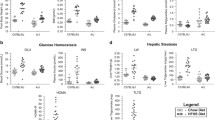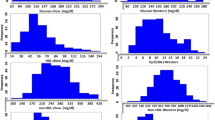Abstract
An F2 pedigree based on the mouse lines DU6i and DBA/2 with extremely different growth and obesity characteristics was generated to search for QTLs affecting serum concentrations of triglycerides (TG), total cholesterol (CHOL), HDL cholesterol (HDL-C), and LDL cholesterol (LDL-C). Compared with many other studies, we searched for spontaneous genetic variants contributing to high lipid levels under a standard breeding diet. Significant QTLs for CHOL were identified on chromosomes 4 and 6, and a female-specific locus on chromosome 3. QTLs for HDL-C were detected on chromosome 11 for both sexes, and on chromosome 1 for females. These QTLs are located in syntenic human regions that have QTLs that have not been previously confirmed in animal studies. LDL-C QTLs have been mapped for both sexes to chromosome 8 and in males on chromosome 13. Epistatic interactions that significantly accounted for the phenotypic variance of HDL-C, CHOL, and LDL-C serum concentrations were also detected with one interaction between chromosomes 8 and 15, accounting for 22% of the observed variance in LDL-C levels. The identified loci coincide in part with regions controlling growth and obesity. Thus, multiple genes or pleiotropic effects may be assumed. The identified QTLs for cholesterol and its transport proteins as subcomponents of risk for coronary heart disease will further improve our understanding of the genetic net controlling plasma lipid concentrations.



Similar content being viewed by others
References
Anunciado RV, Nishimura M, Mori M, Ishikawa A, Tanaka S, et al. (2003) Quantitative trait locus analysis of serum insulin, triglyceride, total cholesterol and phospholipid levels in the (SM/J × A/J)F2 mice. Exp Anim 52:37–42
Brockmann GA, Bevova MR (2002) Using mouse models to dissect the genetics of obesity. Trends Genet 18:367–376
Brockmann GA, Haley CS, Renne U, Knott SA, Schwerin M (1998) Quantitative trait loci affecting body weight and fatness from a mouse line selected for extreme high growth. Genetics 150:369–381
Brockmann GA, Kratzsch J, Haley CS, Renne U, Schwerin M, et al. (2000) Single QTL effects, epistasis, and pleiotropy account for two-thirds of the phenotypic F(2) variance of growth and obesity in DU6i × DBA/2 mice. Genome Res 10:1941–1957
Brockmann GA, Haley CS, Wolf E, Karle S, Kratzsch J, et al. (2001) Genome-wide search for loci controlling serum IGF binding protein levels of mice. FASEB J 15:978–987
Bunger L, Laidlaw A, Bulfield G, Eisen EJ, Medrano JF, et al. (2001) Inbred lines of mice derived from long-term growth selected lines: unique resources for mapping growth genes. Mamm Genome 12:678–686
Canizales-Quinteros S, Aguilar-Salinas CA, Reyes-Rodriguez E, Riba L, Rodriguez-Torres M, et al. (2003) Locus on chromosome 6p linked to elevated HDL cholesterol serum levels and to protection against premature atherosclerosis in a kindred with familial hypercholesterolemia. Circ Res 92:569–576
Churchill GA, Doerge RW (1994) Empirical threshold values for quantitative trait mapping. Genetics 138:963–971
Despres JP (2006) Is visceral obesity the cause of the metabolic syndrome? Ann Med 38:52–63
Expert Panel on Detection, Evaluation, Treatment of High Blood Cholesterol in Adults (2001) Executive Summary of the Third Report of the National Cholesterol Education Program (NCEP) Expert Panel on Detection, Evaluation, and Treatment of High Blood Cholesterol in Adults (Adult Treatment Panel III). JAMA 285:2486–2497
Guyton AC, Hall JE (1996) Lipid metabolism. In: Textbook of medical physiology. 9th ed. WB Saunders Co., Philadelphia, pp 865–876
Haley CS, Knott SA, Elsen JM (1994) Mapping quantitative trait loci in crosses between outbred lines using least squares. Genetics 136:1195–1207
Knott SA, Haley CS (2000) Multitrait least squares for quantitative trait loci detection. Genetics 156:899–911
Korstanje R, Li R, Howard T, Kelmenson P, Marshall J, et al. (2004) Influence of sex and diet on quantitative trait loci for HDL cholesterol levels in an SM/J by NZB/BlNJ intercross population. J Lipid Res 45:881–888
Lander E, Kruglyak L (1995) Genetic dissection of complex traits: guidelines for interpreting and reporting linkage results. Nat Genet 11:241–247
Lilja HE, Suviolahti E, Soro-Paavonen A, Hiekkalinna T, Day A, et al. (2004) Locus for quantitative HDL-cholesterol on chromosome 10q in Finnish families with dyslipidemia. J Lipid Res 45:1876–1884
Lusis AJ (2000) Atherosclerosis. Nature 407:233–241
Nigam A, Bourassa MG, Fortier A, Guertin MC, Tardif JC (2006) The metabolic syndrome and its components and the long-term risk of death in patients with coronary heart disease. Am Heart J 151:514–521
Park YW, Zhu S, Palaniappan L, Heshka S, Carnethon MR, et al. (2003) The metabolic syndrome: prevalence and associated risk factor findings in the US population from the Third National Health and Nutrition Examination Survey, 1988–1994. Arch Intern Med 163:427–436
Peacock JM, Arnett DK, Atwood LD, Myers RH, Coon H, et al. (2001) Genome scan for quantitative trait loci linked to high-density lipoprotein cholesterol: The NHLBI Family Heart Study. Arterioscler Thromb Vasc Biol 21:1823–1828
Rollins J, Chen Y, Paigen B, Wang X (2006) In search of new targets for plasma high-density lipoprotein cholesterol levels: promise of human-mouse comparative genomics. Trends Cardiovasc Med 16:220–234
SAS Institute (1990) User’s guide: Statistics (Cary, NC: SAS Institute)
Schüler L (1985) Mouse strain Fzt:Du and its use as model in animal breeding research. Arch Tierz 28:357–363
Sen S, Churchill GA (2001) A statistical framework for quantitative trait mapping. Genetics 159:371–387
Sugiyama F, Churchill GA, Higgins DC, Johns C, Makaritsis KP, et al. (2001) Concordance of murine quantitative trait loci for salt-induced hypertension with rat and human loci. Genomics 71:70–77
Svenson KL, Von Smith R, Magnani PA, Suetin HR, Paigen B, et al. (2007) Multiple trait measurements in 43 inbred mouse strains capture the phenotypic diversity characteristic of human populations. J Appl Physiol 102:2369–2378
Valdar W, Solberg LC, Gauguier D, Burnett S, Klenerman P, et al. (2006) Genome-wide genetic association of complex traits in heterogeneous stock mice. Nat Genet 38:879–887
Wang X, Paigen B (2002) Quantitative trait loci and candidate genes regulating HDL cholesterol: a murine chromosome map. Arterioscler Thromb Vasc Biol 22:1390–1401
Wang X, Paigen B (2005a) Genetics of variation in HDL cholesterol in humans and mice. Circ Res 96:27–42
Wang X, Paigen B (2005b) Genome-wide search for new genes controlling plasma lipid concentrations in mice and humans. Curr Opin Lipidol 16:127–137
Wang X, Ishimori N, Korstanje R, Rollins J, Paigen B (2005) Identifying novel genes for atherosclerosis through mouse-human comparative genetics. Am J Hum Genet 77:1–15
Welch CL, Bretschger S, Wen PZ, Mehrabian M, Latib N, et al. (2004) Novel QTLs for HDL levels identified in mice by controlling for Apoa2 allelic effects: confirmation of a chromosome 6 locus in a congenic strain. Physiol Genomics 17:48–59
Acknowledgments
Excellent technical assistance was provided by Hannelore Tychsen for DNA preparation and genotyping. We thank Jürgen Kratzsch from the Department of Clinical Chemistry and Pathobiochemistry at the University of Leipzig, and Beate Gomolka for their help in the evaluation of lipid measurements in mice. This work was supported by grants from the German Research Foundation (BR 1285/5), the German National Genome Research Network (NGFN2, registration no. 01GS0486), and the H. Wilhelm Schaumann Stiftung to GAB. CSH acknowledges support from the BBSRC and MAFF.
Author information
Authors and Affiliations
Corresponding author
Electronic supplementary material
Rights and permissions
About this article
Cite this article
Brockmann, G.A., Karatayli, E., Neuschl, C. et al. Genetic control of lipids in the mouse cross DU6i × DBA/2. Mamm Genome 18, 757–766 (2007). https://doi.org/10.1007/s00335-007-9068-7
Received:
Accepted:
Published:
Issue Date:
DOI: https://doi.org/10.1007/s00335-007-9068-7




